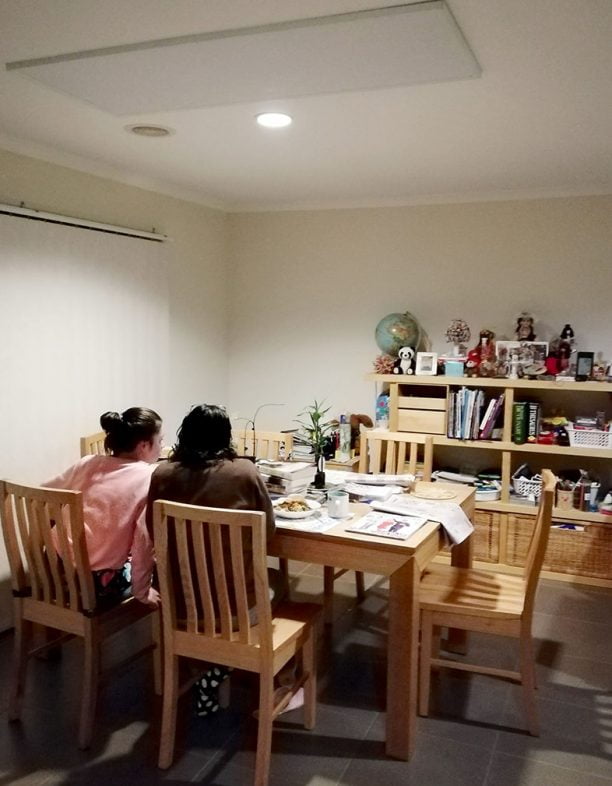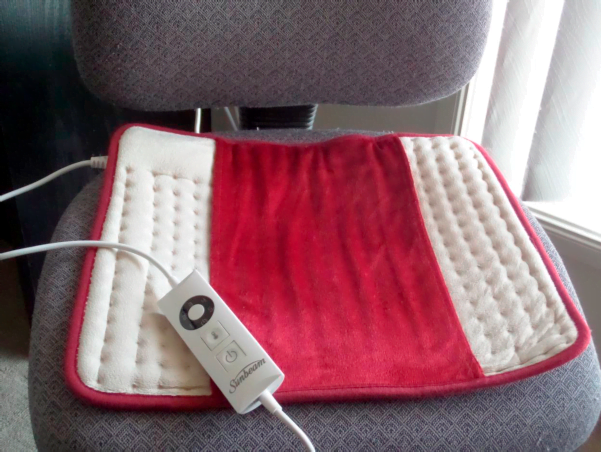Heating people, not spaces: the advantages of personal heating


How much energy can you save by heating yourself instead of your home? Will you be as comfortable? Dave Southgate describes his personal heating experiment.
In late 2012 we moved into a fairly normal, five-year-old, four-bedroom home in the Canberra suburbs. As with many Canberra houses, it was a ‘gas house’, using gas for heating, hot water and cooking. Around this time, frustrated by the lack of government progress on climate change, we decided that we would set out to become a fossil fuel free family.
Getting off gas was clearly fundamental to our plans. More than half of our gas use in 2013 went into our gas ducted central heating—about 6000 kWh (21,600 MJ) over the year.
When we started out on our household energy transition, I envisaged that we would be using heat pumps to replace our gas heating (that’s what everyone else seemed to be doing!), but my wife, Donna, had other ideas. She said that heat pumps didn’t make her feel warm, so we began to search for alternative low energy ways to heat our house. It’s a long story which I’ve written about elsewhere, but we started by installing far infrared (FIR) heating panels. The main photo shows one of two FIR panels which we installed on the ceiling in our living/dining area.
Moving away from space heating…
The FIR panels produce a wonderful radiant heat and I was happy that my wife had diverted us onto a different path. However, when we first installed the panels we simply used them as space heaters and controlled the room air temperature using a thermostat. It didn’t take us too long (but probably longer than it should have) to work out that this was not very smart. When we were sitting under the panels the temperature of the air in the room had virtually no influence on how warm we felt. Our feeling of thermal comfort came from the direct radiant heat from the panels, not from the heat in the ambient air. Why heat all the air in the room when we didn’t need to? Consequently, we changed our heating habits: we only turned on an FIR panel when we were sitting under it and no longer worried about the room air temperature; the thermostat became redundant. This gave us some serious energy savings with no loss of thermal comfort.
This simple chain of events totally changed the way I now think about heating. I came to the realisation that what is important in heating is not how warm the air in a house is, but, rather, how warm the occupants feel! I quickly adopted the philosophy ‘heat people, not spaces’.
…into the world of personal heating
Once we changed our focus to heating people, rather than heating air, whole new horizons opened up. We moved into the wonderful world of personal heating devices (PHDs).
All things being equal, you would expect that the closer a heat source is to a person looking for warmth, the less energy will be required to provide that warmth. There are a wide array of devices on the market that consume less than 50 W, but that can provide beautiful comfort via thermal conduction.
We ventured on a PHD testing campaign which ranged from heated clothing, to heated rugs, small heated pads and foot-warmers. For the most part, these devices cost less than $100 each. One of the devices we tested, and which is now my wife’s favourite, is a heated seat pad (see photo). This testing regime also led us to try out a number of passive PHDs (devices requiring no energy input), such as fluffy dressing gowns, ‘onesies’ and sleeved blankets. You can see the list of PHDs we tried in the original article (see Renew 144 in webshop).
Personally, I have found that with the right passive heating devices (thermal clothing and a fluffy top layer), I can be extremely comfortable for extended periods of time in a room with an air temperature of about 13°C, without any input of external energy.
I have produced a report on this, but, in summary, PHDs really do work. I have been extremely surprised by the amount of thermal comfort that around 30 W of conducted heat can deliver. It makes our conventional heating systems based on warm air circulation appear very inefficient!

